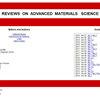稀土Nd对7xxx系列铝合金组织转变及力学性能的影响
IF 3.6
4区 材料科学
Q2 MATERIALS SCIENCE, MULTIDISCIPLINARY
引用次数: 1
摘要
Al-Zn-Mg-Cu-Zr铝合金作为钻杆材料具有广阔的应用前景;然而,它们的应用温度限制在120°C以下。研究了稀土元素Nd对Al-Zn-Mg-Cu-Zr合金显微组织和力学性能的影响。利用光学显微镜和扫描电镜对铸件在铸造、均匀化、热变形和热处理过程中的组织演变进行了表征。通过透射电子显微镜(TEM)测定了稀土相的组成。利用第一性原理计算确定了Al8Cu4Nd的形成焓、黏结能、剪切模量、体积模量、杨氏模量和泊松比。通过硬度和拉伸试验研究了Nd对合金力学性能的影响。结果表明,Nd的加入能显著细化合金的晶粒尺寸和枝晶尺寸,有效抑制合金在热挤压和固溶过程中的再结晶行为。透射电镜观察发现存在微米尺寸的块状Al8Cu4Nd相和纳米尺寸的Al3Nd相。Al3Nd相位于位错附近,阻碍了位错的移动,从而提高了合金的力学性能。第一性原理计算表明,大块Al8Cu4Nd相具有优异的组织稳定性、抗变形性和脆性,这对合金的延展性有不利影响。Nd添加量为0.26 wt%的合金在高温下能长时间保持较高的硬度值,120℃时抗拉强度达到396.2 MPa。结果表明,稀土元素Nd可以改善合金的高温力学性能。本文章由计算机程序翻译,如有差异,请以英文原文为准。
Effect of rare earth Nd on the microstructural transformation and mechanical properties of 7xxx series aluminum alloys
Abstract Al–Zn–Mg–Cu–Zr aluminum alloys have shown promise as materials for drill pipes; however, their application temperature is limited to below 120°C. This study investigates the influence of incorporating the rare earth element Nd on the microstructure and mechanical properties of Al–Zn–Mg–Cu–Zr alloys. The microstructural evolution during casting, homogenization, hot deformation, and heat treatment processes is characterized using optical microscopy and scanning electron microscopy. The composition of the rare earth phase is determined through transmission electron microscopy (TEM). Furthermore, first-principles calculations are employed to determine the formation enthalpy, cohesive energy, shear modulus, bulk modulus, Young’s modulus, and Poisson’s ratio of bulk Al8Cu4Nd. The effect of Nd addition on the mechanical properties of the alloy is investigated through hardness and tensile testing. The results indicate that the addition of Nd significantly refines the grain and dendrite sizes of the alloy and effectively suppresses recrystallization behavior during hot extrusion and solution treatment. TEM observations reveal the presence of micrometer-sized blocky Al8Cu4Nd phases and nanometer-sized Al3Nd phases. The Al3Nd phases are located near dislocations, hindering dislocation movement and thus enhancing the alloy’s mechanical properties. First-principles calculations demonstrate that the bulk Al8Cu4Nd phase exhibits superior structural stability, deformation resistance, and brittle characteristics, which negatively impact the ductility of the alloy. The alloy with Nd addition can maintain a high hardness value for an extended period at high temperature, and the tensile strength of the alloy with 0.26 wt% Nd addition reaches 396.2 MPa at 120°C. These results indicate that the rare earth element Nd can improve the high-temperature mechanical properties of the alloy.
求助全文
通过发布文献求助,成功后即可免费获取论文全文。
去求助
来源期刊

Reviews on Advanced Materials Science
工程技术-材料科学:综合
CiteScore
5.10
自引率
11.10%
发文量
43
审稿时长
3.5 months
期刊介绍:
Reviews on Advanced Materials Science is a fully peer-reviewed, open access, electronic journal that publishes significant, original and relevant works in the area of theoretical and experimental studies of advanced materials. The journal provides the readers with free, instant, and permanent access to all content worldwide; and the authors with extensive promotion of published articles, long-time preservation, language-correction services, no space constraints and immediate publication.
Reviews on Advanced Materials Science is listed inter alia by Clarivate Analytics (formerly Thomson Reuters) - Current Contents/Physical, Chemical, and Earth Sciences (CC/PC&ES), JCR and SCIE. Our standard policy requires each paper to be reviewed by at least two Referees and the peer-review process is single-blind.
 求助内容:
求助内容: 应助结果提醒方式:
应助结果提醒方式:


